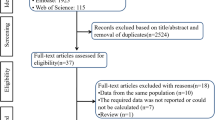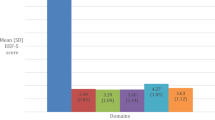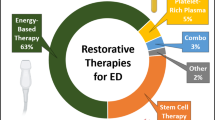Abstract
A systematic review was conducted on the prevalence of erectile dysfunction (ED) in the general population. Studies were retrieved which reported prevalence rates of ED in the general population. Using a specially developed criteria list, the methodological quality of these studies was assessed and data on prevalence rates were extracted. We identified 23 studies from Europe (15), USA (5), Asia (2) and Australia (1). On our 12-item criteria list, the methodological quality ranged from 5 to 12. The prevalence of ED ranged from 2% in men younger than 40 y to 86% in men 80 y and older. Comparison between prevalence data is hampered by major methodological differences between studies, particularly in the use of various questionnaires and different definitions of ED. We stress the importance of providing all necessary information when reporting on the prevalence of ED. Moreover, international studies should be conducted to establish the true prevalence of ED across countries.
This is a preview of subscription content, access via your institution
Access options
Subscribe to this journal
Receive 8 print issues and online access
$259.00 per year
only $32.38 per issue
Buy this article
- Purchase on Springer Link
- Instant access to full article PDF
Prices may be subject to local taxes which are calculated during checkout
Similar content being viewed by others
References
Wagner G, Saenz de Tejada I . Update on male erectile dysfunction Br Med J 1998; 316: 678–682.
Lewis RW . Epidemiology of erectile dysfunction Urol Clin N Am 2001; 28: 209–116 vii.
Melman A, Gingell JC . The epidemiology and pathophysiology of erectile dysfunction J Urol 1999; 161: 5–11.
Lerner SE, Melman A, Christ GJ . A review of erectile dysfunction: new insights and more suggestions J Urol 1993; 149: 1246–1255.
Bortolotti A, Parazzini F, Colli E, Landoni M . The epidemiology of erectile dysfunction and risk factors Int J Androl 1997; 20: 323–334.
Breslow RA, Ross SA, Weed DL . Quality of reviews in epidemiology Am J Public Health 1998; 88: 475–477.
Diokno AC, Brown MB, Herzog AR . Sexual function in the elderly Arch Intern Med 1990; 150: 197–200.
Solstad K, Hertoft P . Frequency of sexual problems and sexual dysfunction in middle-aged Danish men Arch Sex Behav 1993; 22: 51–58.
Solstad K, Davidsen M . Sexual behaviour and attitudes of Danish middle-aged men—methodological considerations Maturitas 1993; 17: 139–149.
Feldman HA et al. Impotence and its medical and psychosocial correlates: results of the Massachusetts Male Aging Study J Urol 1994; 151: 54–61.
Araujo AB et al. The relationship between depressive symptoms and male erectile dysfunction: cross-sectional results from the Massachusetts Male Aging Study Psychosom Med 1998; 60: 458–465.
Kleinman KP et al. A new surrogate variable for erectile dysfunction status in the Massachusetts male aging study J Clin Epidemiol 2000; 53: 71–87.
Derby CA et al. Measurement of erectile dysfunction in population-based studies: the use of a single question self-assessment in the Massachusetts Male Aging Study Int J Impot Res 2000; 12: 197–204.
Panser LA et al. Sexual function of men ages 40 to 79 years: the Olmsted County Study of Urinary Symptoms and Health Status Among Men J Am Geriatr Soc 1995; 43: 1107–1111.
Panser LA et al. The natural history of prostatism: the effects of non-response bias Int J Epidemiol 1994; 23: 1198–1205.
Epstein RS et al. Validation of a new quality of life questionnaire for benign prostatic hyperplasia J Clin Epidemiol 1992; 45: 1431–1445.
Helgason AR et al. Sexual desire, erection, orgasm and ejaculatory functions and their importance to elderly Swedish men: a population-based study Age Ageing 1996; 25: 285–291.
Helgason AR et al. Factors associated with waning sexual function among elderly men and prostate cancer patients J Urol 1997; 158: 155–159.
Macfarlane GJ et al. The relationship between sexual life and urinary condition in the French community J Clin Epidemiol 1996; 49: 1171–1176.
Sagnier PP et al. Results of an epidemiological survey using a modified American Urological Association symptom index for benign prostatic hyperplasia in France J Urol 1994; 151: 1266–1270.
Malmsten UG, Milsom I, Molander U, Norlen LJ . Urinary incontinence and lower urinary tract symptoms: an epidemiological study of men aged 45 to 99 years J Urol 1997; 158: 1733–1737.
Ventegodt S . Sex and the quality of life in Denmark Arch Sex Behav 1998; 27: 295–307.
Frankel SJ et al. Sexual dysfunction in men with lower urinary tract symptoms J Clin Epidemiol 1998; 51: 677–685.
Jolleys JV et al. Urinary symptoms in the community: how bothersome are they? Br J Urol 1994; 74: 551–555.
Koskimäki J, Hakama M, Huhtala H, Tammela TL . Effect of erectile dysfunction on frequency of intercourse: a population based prevalence study in Finland J Urol 2000; 164: 367–370.
Dunn KM, Croft PR, Hackett GI . Sexual problems: a study of the prevalence and need for health care in the general population Fam Pract 1998; 15: 519–524.
Dunn KM, Croft PR, Hackett GI . Association of sexual problems with social, psychological, and physical problems in men and women: a cross sectional population survey J Epidemiol Community Health 1999; 53: 144–148.
Laumann EO, Paik A, Rosen RC . Sexual dysfunction in the United States: prevalence and predictors JAMA 1999; 281: 537–544.
Fugl-Meyer AR . Sexual disabilities, problems and satisfaction in 18–74 year old Swedes Scand J Sexol 1999; 2: 79–105.
Helmius G . The Swedish sex survey. An introduction and remarks on changes in early sexual experiences Scand J Sexol 1998; 1: 63–70.
Tsukamoto T et al. Prevalence of prostatism in Japanese men in a community-based study with comparison to a similar American study J Urol 1995; 154: 391–395.
Masumori N et al. Decline of sexual function with age in Japanese men compared with American men-results of two community-based studies Urology 1999; 54: 335–344.
Pinnock CB, Stapleton AM, Marshall VR . Erectile dysfunction in the community: a prevalence study Med J Aust 1999; 171: 353–357.
Pinnock C, Marshall VR . Troublesome lower urinary tract symptoms in the community: a prevalence study Med J Aust 1997; 167: 72–75.
Parazzini F et al. Frequency and determinants of erectile dysfunction in Italy Eur Urol 2000; 37: 43–49.
Kongkanand A . Prevalence of erectile dysfunction in Thailand. Thai Erectile Dysfunction Epidemiological Study Group Int J Androl 2000; 23: 77–80.
Group TEDES . An epidemiological study of erectile dysfunction in Thailand (Part 1: Prevalence) J Med Assoc Thai 2000; 83: 872–879.
Ansong KS, Lewis C, Jenkins P, Bell J . Epidemiology of erectile dysfunction: a community-based study in rural New York State Ann Epidemiol 2000; 10: 293–296.
Braun M et al. Epidemiology of erectile dysfunction: results of the ‘Cologne Male Survey’ Int J Impot Res 2000; 12: 305–311.
Meuleman EJ et al. [Erectile dysfunction: prevalence and effect on the quality of life; Boxmeer study.] Erectiestoornis: prevalentie en invloed op de kwaliteit van leven; het Boxmeeronderzoek. (In Dutch.) Ned Tijdschr Geneeskd 2001; 145: 576–581.
Boyle P et al. The UrEpiK Study: a cross-sectional survey of benign prostatic hyperplasia, urinary incontinence and male erectile dysfunction, prostatitis and interstitial cystitis in the UK, France, the Netherlands and Korea J Epidemiol Biostat 1998; 3: 179–187.
Blanker MH et al. Strong effects of definition and nonresponse bias on prevalence rates of clinical benign prostatic byperplasia: the Krimpen study of male urogenital tract problems and general health status BJU Int 2000; 85: 665–671.
Blanker MH et al. Correlates for erectile and ejaculatory dysfunction in older Dutch men: a community-based study J Am Geriatr Soc 2001; 49: 436–442.
Blanker MH et al. Erectile and ejaculatory dysfunction in a community-based sample of men 50 to 78 years old: prevalence, concern, and relation to sexual activity Urology 2001; 57: 763–768.
Martin-Morales A et al. Prevalence and independent risk factors for erectile dysfunction in Spain: results of the Epidemiologia de la Disfuncion Erectil Masculina Study J Urol 2001; 166: 569–574.
Green JS et al. An investigation of erectile dysfunction in Gwent, Wales BJU Int 2001; 88: 551–553.
Gentili A, Mulligan T . Sexual dysfunction in older adults Clin Geriatr Med 1998; 14: 383–393.
Korenman SG . Clinical review 71: advances in the understanding and management of erectile dysfunction J Clin Endocrinol Metab 1995; 80: 1985–1988.
Monga M . The aging penis: erectile dysfunction Geriatr Nephrol Urol 1999; 9: 27–37.
Morley JE . Impotence Am J Med 1986; 80: 897–905.
Spector IP, Carey MP . Incidence and prevalence of the sexual dysfunctions: a critical review of the empirical literature Arch Sex Behav 1990; 19: 389–408.
Avis NE . Sexual function and aging in men and women: community and population-based studies J Gend Specif Med 2000; 3: 37–41.
Benet AE, Melman A . The epidemiology of erectile dysfunction Urol Clin N Am 1995; 22: 699–709.
Cohan P, Korenman SG . Erectile dysfunction J Clin Endocrinol Metab 2001; 86: 2391–2394.
Simons JS, Carey MP . Prevalence of sexual dysfunctions: results from a decade of research Arch Sex Behav 2001; 30: 177–219.
Oxman AD . Checklists for review articles Br Med J 1994; 309: 648–651.
Stroup DF et al. Meta-analysis of observational studies in epidemiology: a proposal for reporting. Meta-analysis Of Observational Studies in Epidemiology (MOOSE) group JAMA 2000; 283: 2008–2012.
NIH Consensus Development Panel on Impotence. NIH Consensus Conference. Impotence JAMA 1993; 270: 83–90.
Acknowledgements
The authors thank Mrs Arianne Verhagen for her methodological comments and suggestions on the manuscript.
Author information
Authors and Affiliations
Corresponding author
Rights and permissions
About this article
Cite this article
Prins, J., Blanker, M., Bohnen, A. et al. Prevalence of erectile dysfunction: a systematic review of population-based studies. Int J Impot Res 14, 422–432 (2002). https://doi.org/10.1038/sj.ijir.3900905
Received:
Revised:
Published:
Issue Date:
DOI: https://doi.org/10.1038/sj.ijir.3900905
Keywords
This article is cited by
-
Comment on “Premature ejaculation among men with erectile dysfunction—findings from a real-life cross-sectional study”
International Journal of Impotence Research (2023)
-
Correlates of Physical Activity in 0- to 5-year-olds: A Systematic Umbrella Review and Consultation of International Researchers
Sports Medicine (2023)
-
Heart Failure and Erectile Dysfunction: a Review of the Current Evidence and Clinical Implications
Current Heart Failure Reports (2023)
-
Erectile dysfunction among patients and health care providers during COVID-19 pandemic: A systematic review
International Journal of Impotence Research (2022)
-
Erectile dysfunction in patients with anxiety disorders: a systematic review
International Journal of Impotence Research (2022)



